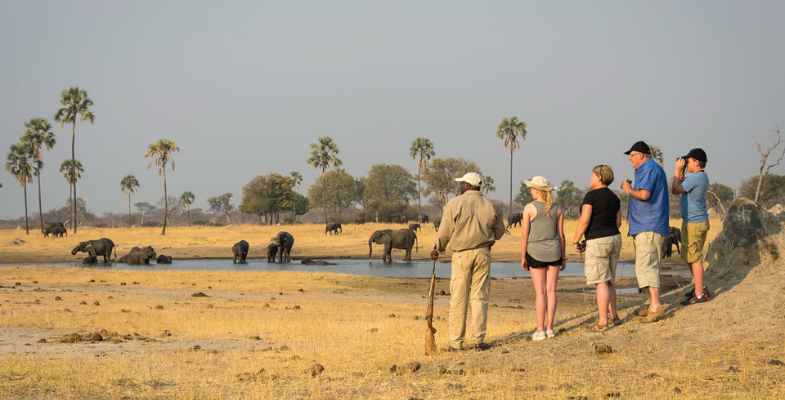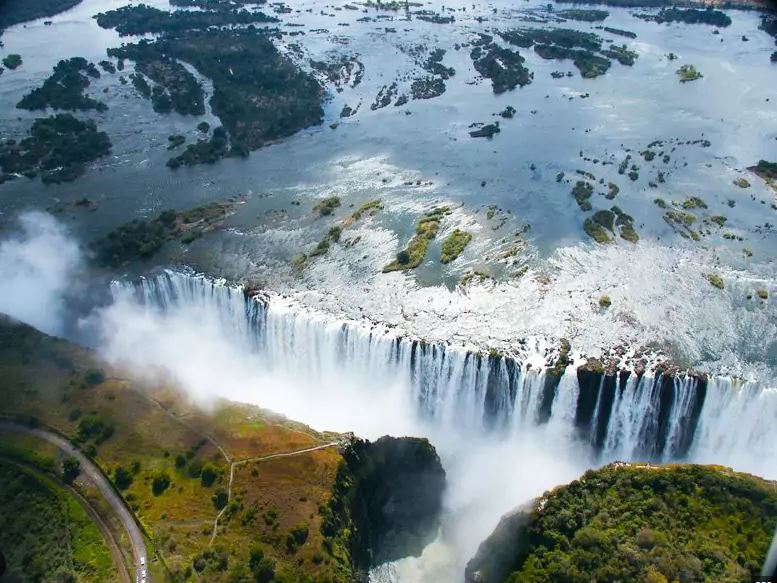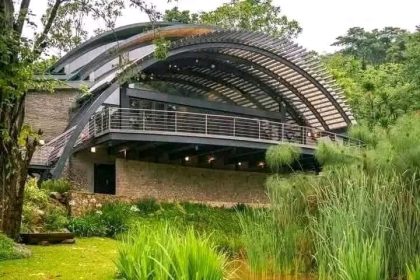Zimbabwe is home to one side of the striking Victoria Falls, one of the Seven Natural Wonders of the World, which it shares with its neighbor, Zambia. Zimbabwe and Zambia each offer a distinct perspective of this 354-foot-high waterfall. Join us as we explore Zimbabwe’s side of Vic Falls and what to expect below.
Longer Waterfront: Zimbabwe boasts a longer stretch along the Zambezi River, providing visitors with numerous viewpoints and a broader perspective of the Falls.
Accessibility and Viewpoints: Compared to the Zambian side, the Falls’ Zimbabwean side offers more vantage points that are easily accessible throughout the year, allowing visitors to experience different aspects of the Falls regardless of the season.
Victoria Falls Rainforest: A unique feature on the Zimbabwean side is the lush rainforest, sustained by the constant spray from the Falls. Many active and outdoorsy travelers enjoy hiking through the rainforest on the 2.4-mile loop trail – boasting 16 viewpoints along the way.
Adventure Activities: While both sides offer adventure activities, Zimbabwe’s side is famous for its bungee jumping from the Victoria Falls Bridge, canopy tours, and the heart-racing zip-line experience across the Batoka Gorge. Definitely an adrenaline junkie’s paradise!
Wildlife and Bird Watching: The proximity to the Zambezi National Park and Victoria Falls National Park makes Zimbabwe an ideal spot for wildlife and bird watching.
Statue of David Livingstone: A notable historical landmark on this side of the Falls is the statue of David Livingstone, the Scottish explorer who is believed to be the first European to view this Wonder of the World.
Nighttime Viewing: During the full moon, the Zimbabwean side offers ‘moonbow’ viewings, a rare natural phenomenon where a rainbow is formed by moonlight reflecting off the mist of the Falls.
Consistent Water Flow: Even in the dry season, the Zimbabwean side retains a more consistent water flow, ensuring visitors can experience the beauty of the Falls all year round.
When is the best time to visit Victoria Falls in Zimbabwe?

If you want to see the Falls at their most powerful, visit during the high water season. For clearer views, the low water season is preferable. Consider the dry season if you’d like to combine Vic Falls with a safari, and opt for the rainy season if you want to see colorful rainbows and prefer to avoid crowds.
High Water Season (February to July):
At this time of year, the Falls are at their most spectacular, with massive volumes of water cascading over the edge. However, the heavy mist generated can obscure the full view of the Falls and make some of the paths slippery.
Low Water Season (August to January):
This is when the water level is considerably lower, revealing more of the rock face and the individual streams of the waterfall. The reduced mist during this season offers clearer views and better photo opportunities of the Falls.
Dry Season (May to October):
This is generally considered the best time for wildlife viewing in the surrounding national parks. The weather is pleasant, with cooler temperatures and little rainfall, causing water levels to decrease, gradually revealing the rocky face of the Falls.
Rainy Season (November to April):
From late November, the landscape is lush and green, offering a different kind of beauty. Heavy rains can lead to muddy conditions and less visibility of the Falls due to the mist. However, it is the ideal season to catch rainbows and moonbows.
What are the visa requirements for Zimbabwe travel?

Visa requirements for Zimbabwe vary depending on nationality. It’s possible to apply for an e-visa to avoid airport queues or obtain a visa on arrival – don’t forget to check the latest regulations and fees before traveling.
For those planning to visit both Zambia and Zimbabwe, the KAZA Univisa is a great option. This single visa allows multiple entries into both countries and is valid for up to 30 days. Citizens of eligible countries can obtain it on arrival or online.
Source: Giltedge Ttravel







